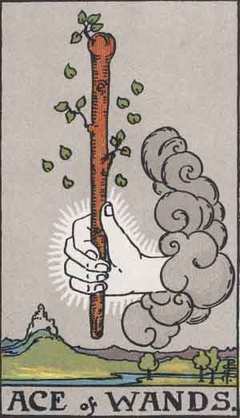Lesson 4 - The numbered cards 1 to 10 of the Suit of Wands

So how do you feel about working with the Major Arcana now? Did you find doing your 3 card reading enlightening or simply baffling!!
Hey, it takes time, keep practising that reading. Working with just the Major Arcana can give very insightful readings.
Part of your study this week is to find a trusting friend (not family because that's too close) and have them ask a question of the cards and see how you get on!! Don't be embarrassed or afraid to use your book(s) when you first start practising reading cards for your friends, they won't mind and it will help build up your confidence.
Time now to move on to the Minor Arcana! ...
Lesson 4 now takes you on to the Minor Arcana cards which generally refer to practical issues and the more everyday or mundane events in our lives.
The 56 Minor Arcana cards can be used separately for a reading or within the full Tarot deck.
Wands
The first suit of the Minor Arcana is the Wands or Rods or Batons as they are sometimes called.
This suit is associated with the element Fire, a creative force that can illuminate and warm, or if uncontrolled will burn and destroy.
Wands represent the creative urge and imagination, and the will to bring one's dreams into reality. In a reading they refer to career, work, enterprise and ambition.
Positive attitudes associated with this suit are enthusiasm, determination and passion.
Negative attitudes associated with Wands are reckless behaviour and subsequent disappointment.
As you are no doubt starting to realise there is a lot of information to take in about the 78 cards!! So during this introductory course we're not going to cover the positive and negative aspects of the Minor Arcana in detail, but rather focus on the key words and values associated with each of the numbered cards.
Take out from your deck the numbered cards 1-10 of Wands and keep the remaining cards wrapped in your cloth.
Like you have done in previous lessons focus on the first card, the Ace of Wands, and try and memorise some of the key words associated with the card. Make notes of any words or symbols you get from the card before moving onto the next one. Do this until you have done all 10.
Depending on the deck you are using, you may be able to see the key concepts of the card in the picture. If it isn't obvious, try to find some aspect of the imagery of the card that will remind you of the keywords. The human brain remembers pictures and symbols far better than words and numbers, so this will help you a lot.
Try to get the image of the card to 'talk to you', rather than just trying to remember that ace is such and such and 2 is such and such. This will become very important when you are giving full readings using more complex spreads.
